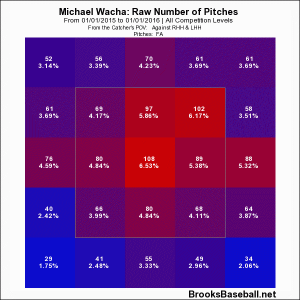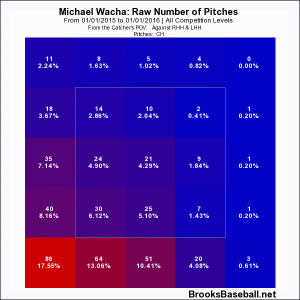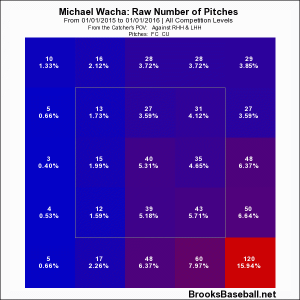If you like reading the words “four-seam fastball,” then a scouting report about Michael Wacha is the piece for you. With Wacha, it is all about that pitch, and the Cubs know that well entering Monday’s Game Three of the NLDS.
Wacha was still averaging 95.04 mph on his four-seam fastball in September, going to the pitch with 62 percent frequency, about seven percentage points above his season average. On the season, Wacha’s secondary pitch against right-handed batters was a cutter, which he threw 18 percent of the time. His secondary pitch against left-handed batters was a change, which he threw 26 percent of the time.
The Cubs are familiar with Wacha, who made four starts against against the Cubs in 2015, two in September, and posted the following numbers:
| AVG Start | AVGGS | WHIP | ERA | K% | BB% | Whiffs | OPS | ISO | EXBH | BABIP |
| 5.3 IP | 42.3 | 1.667 | 6.86 | 21.5% | 10.8% | 51 | .919 | .241 | 11 | .356 |
By Game Score, Wacha’s worst and third worst starts of the season game against the Cubs. The Cubs made Wacha work, averaging 4.22 pitches per plate appearance, above his 3.85 average during the regular season. In September, he surrendered home runs to Rizzo, Castro, Bryant, and Soler. Against Wacha, the Cubs did an exceptional job of doing the two things they did best offensively in 2015: work deep counts and hit for power.
Wacha had a horrible September overall, posting 7.88 ERA and 1.792 WHIP, while the number of batters he walked (18) nearly matched his strikeout total (19). His struggles were due primarily to the astounding ineffectiveness of his four-seam fastball and change, of which he went to 80 percent of all pitches. Batters slugged .529 and hit four home runs against his fastball, and .850 with three home runs against his change. Despite these struggles, Wacha’s combined usage remained the same as April through August.
How Wacha approached the Cubs…
| Pitch | Frequency | AVG | SLP | K | Whiffs |
| Fourseam | 58.4% | .261 | .500 | 9 | 25 |
| Cutter | 10.8% | .500 | .600 | 0 | 4 |
| Change | 18.5% | .316 | .684 | 8 | 13 |
| Curve | 12.3% | .250 | .500 | 0 | 9 |
The Cubs success against Wacha should not come as a shock, considering their 2015 production against four-seam fastballs, especially from those players at the top of the lineup:
| Player | AVG | SLP | HR |
| Fowler | .260 | .481 | 9 |
| Schwarber | .234 | .484 | 5 |
| Rizzo | .278 | .571 | 10 |
| Bryant | .238 | .490 | 7 |
| Coghlan | .259 | .526 | 8 |
| Montero | .22 | .348 | 3 |
| Castro | .273 | .418 | 3 |
| Russell | .234 | .378 | 3 |
| Soler | .352 | .602 | 5 |
| La Stella | .276 | .379 | 0 |
As you can see below, Wacha stayed over the plate with his four-seam fastball this season:
The Cubs swung at 69.4 percent of pitches in the strike zone this season, second highest in the NL. On September 18th, Soler and Bryant hit back-t0-back home runs on 95-mph four-seam fastballs, both left up in the strike zone on the outer half of the plate.
Will Wacha go to his other pitches with increased frequency? Based on his track record, it seems unlikely. Put simply, Wacha lives and dies with his four-seam fastball. Wacha has thrown his fastball with the highest frequency in every start of his career. In fact, he has not thrown fewer than 50 fourseam fastballs in a start since April 23rd.
Wacha had success when…
Wacha’s best start against the Cubs this season was his first on June 27th. In the Cardinals 8-1 win, Wacha posted the following line:
6.0 IP, 6 H, 5 K, 2 BB, 1 ER, 92 pitches (56 strikes), 12 whiffs
So, what did Wacha differently in this start? Not surprisingly, he went to his four-seam fastball just 47.8 percent of all pitches, his lowest rate of any start against the Cubs.
| Pitch | # Thrown | Hits | Balls In Play | Whiffs |
| Fourseam | 42 | 3 | 7 | 4 |
| Cutter | 14 | 1 | 4 | 3 |
| Change | 22 | 1 | 4 | 3 |
| Curve | 10 | 1 | 1 | 2 |
Yadier Molina is a damn smart catcher. He knows in Wacha’s best start against the Cubs this season, he increased his cutter and change usage. After Wacha’s September struggles with his four-seam fastball, especially against this team, the Cubs right-handed batters should be prepared for more cutters, and left-handed batters should be prepared for increased changeups.
When Wacha is ahead…
When Wacha gets ahead in the count, he goes to the four-seam with slightly increased frequency (about 60 percent of all pitches), which should favor the Cubs. This is pertinent, because he threw first-pitch strikes to 60 percent of Cubs hitters this season.
When Bryant, Castro, Russell, and Soler get behind in the count, they should expect the change. He goes to it 33 percent of the time when behind right-handers, and he likes to bury it inside:
When Rizzo, Schwarber, Montero, and Coghlan get behind, Wacha will likely go to the cutter (16 percent) and curve (16 percent). Like he does with right-handed batters, Wacha likes to come bury his pitches to left-handed batters low and inside:
Monday Night…
Wacha is entering this start on the heels of a disastrous final month, in which he could not find success with the pitch he throws with more than 60 percent frequency. Wacha seems to have two paths to success against the Cubs on Monday:
1. Be effective with his four-seam fastball, which he has not been since August
2. Reduce his four-seam fastball frequency, which he does infrequently, but which he did against the Cubs in late June and found success. In that start, he went to his change (25 percent) and cutter (16 percent) above his season averages.
On paper, this seems like an ideal matchup for the Cubs. Wacha struggled with all of his pitches in September, and in their two games against him last month, the Cubs had 19 base runners in nine innings. His primary pitch is his four-seam fastball, with which Wacha lives over the plate. The Cubs as a team hammer four-seam fastballs and are aggressive on pitches over the plate. With Wacha, the Cubs should be looking for fastballs around the plate, while being prepared for off-speed pitches low and inside. Simple, I know, but Wacha has shown great reluctance shake up his approach.
Lead photo courtesy of Charles LeClaire-USA TODAY Sports



